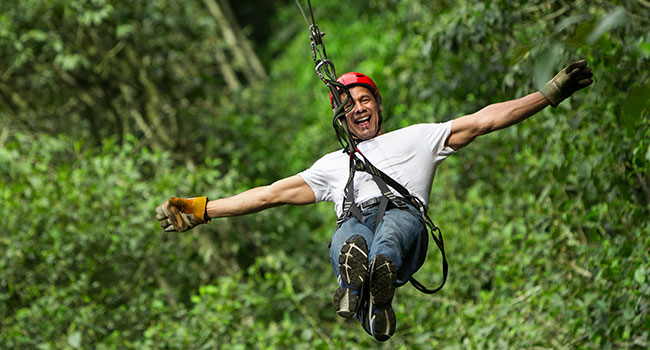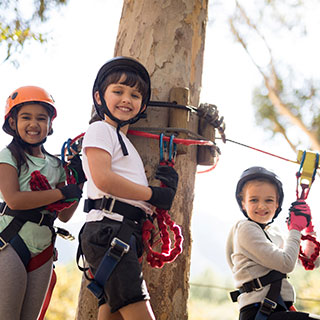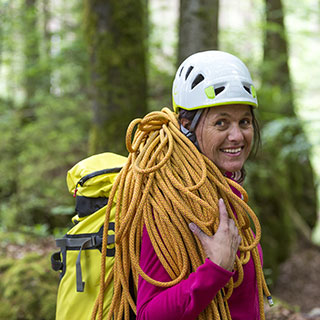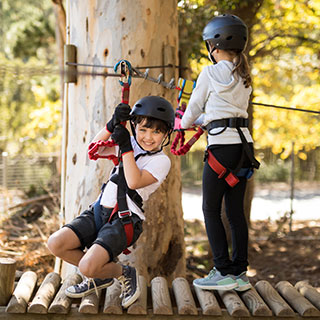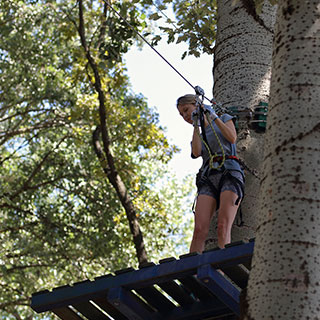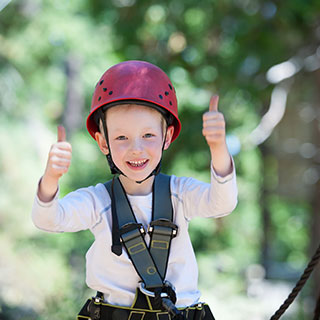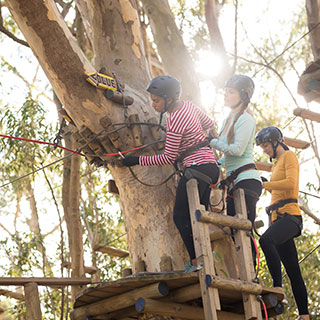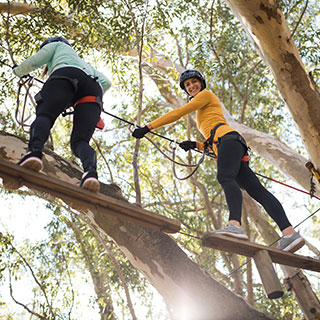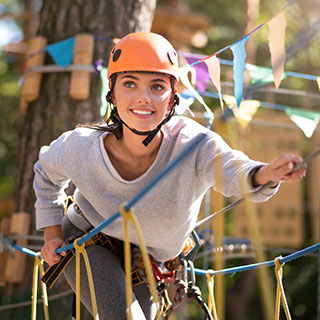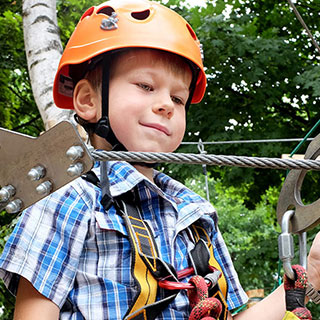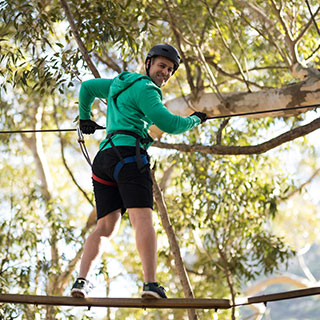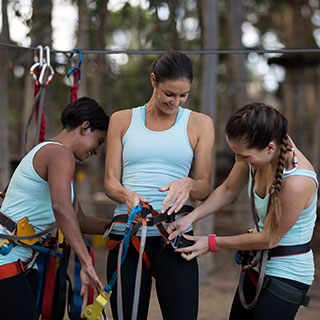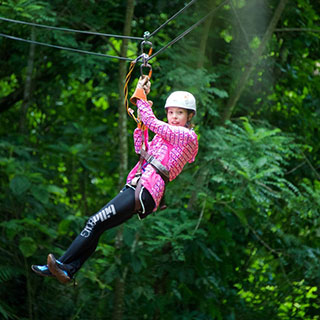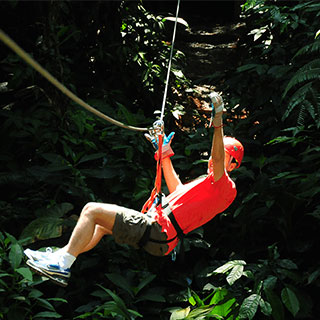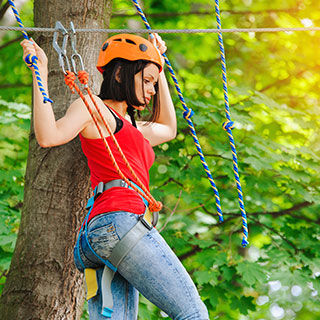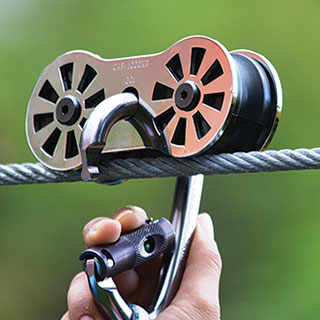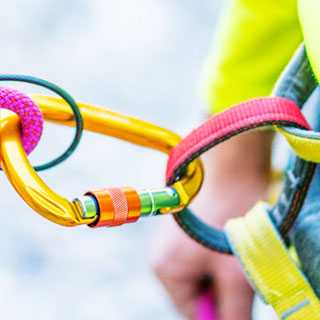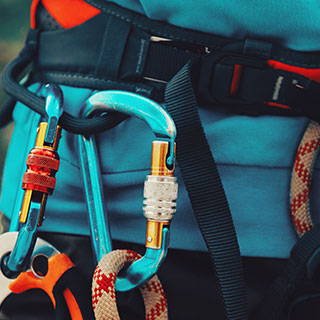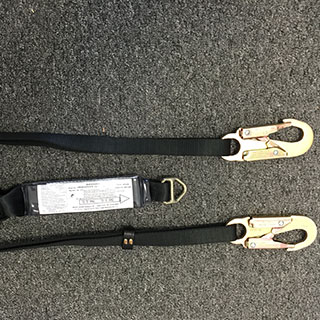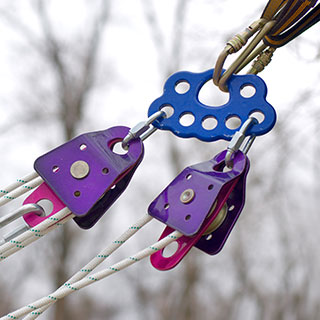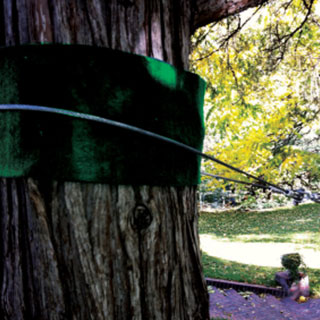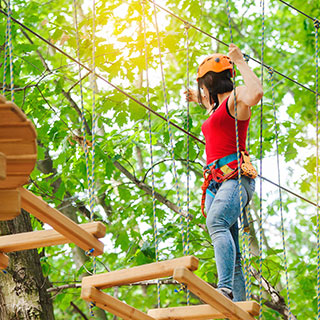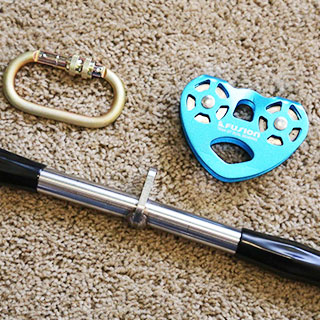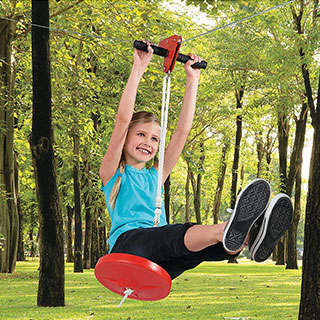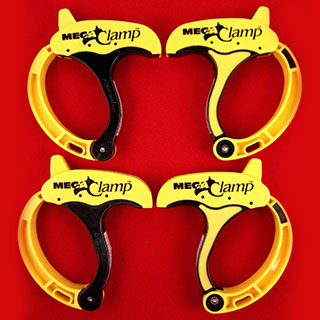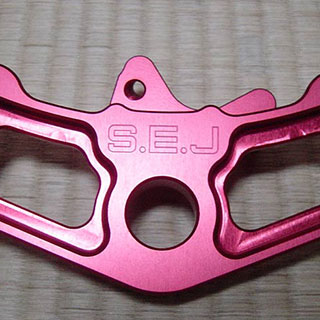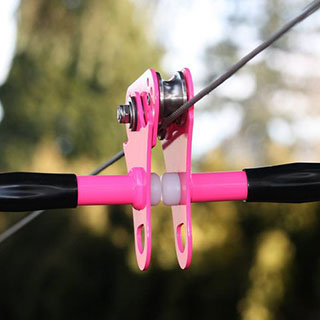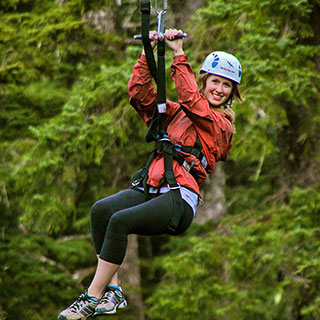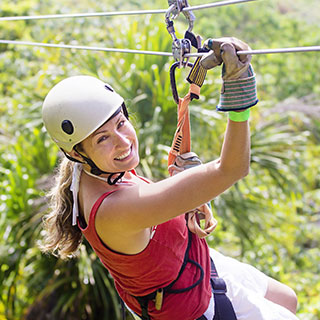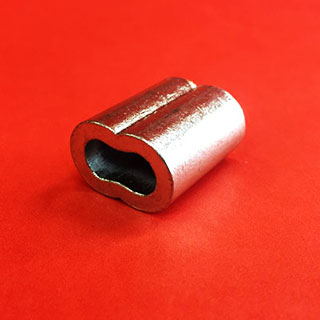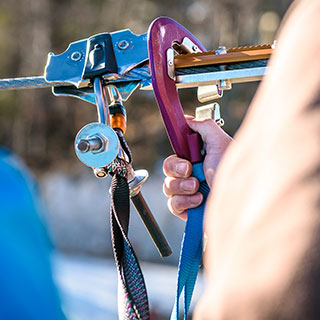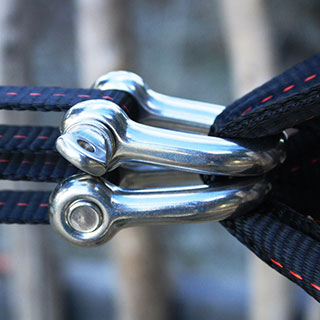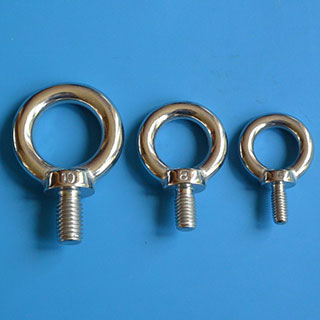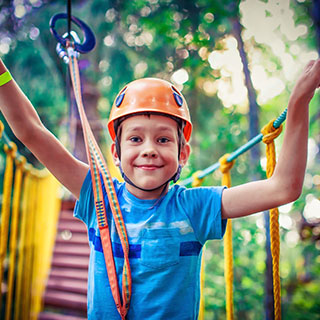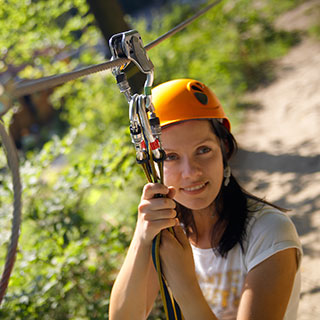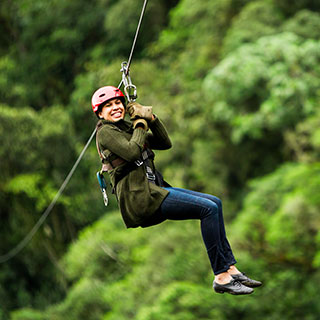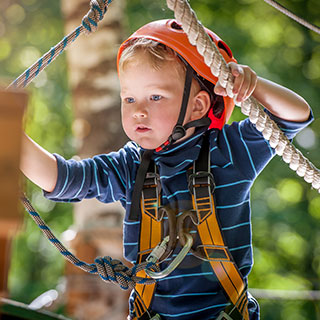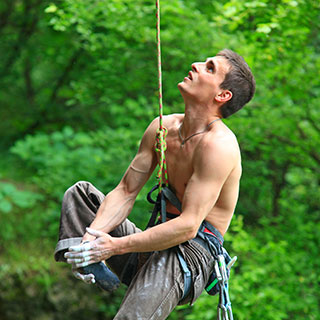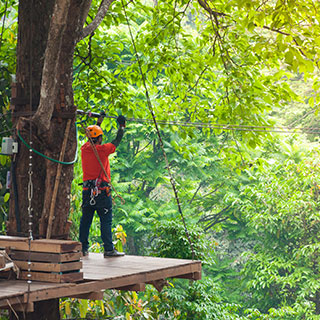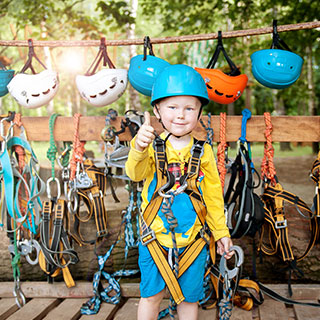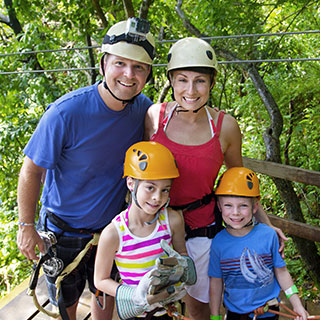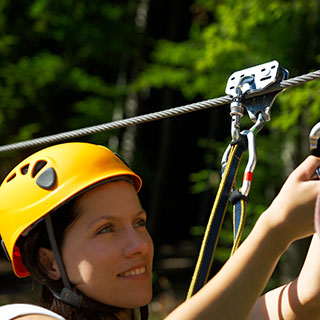Who can set up a zip line? Anyone, really! Zip lines are simple to set up. Anyone with basic handyman skills is fully capable of installing a typical zip line in their home or backyard. Much of the process will depend upon how your backyard is constructed, as you may have to improvise a few items here and there in order to get the zip line that you desire. But with a few basic tools, a plan, and an idea, you can create your own backyard zip line without a problem. Let us know how to do so and get familiar with some essential zipline accessories for backyard.
AT A GLANCE
What to Think Before Building a Zip Line
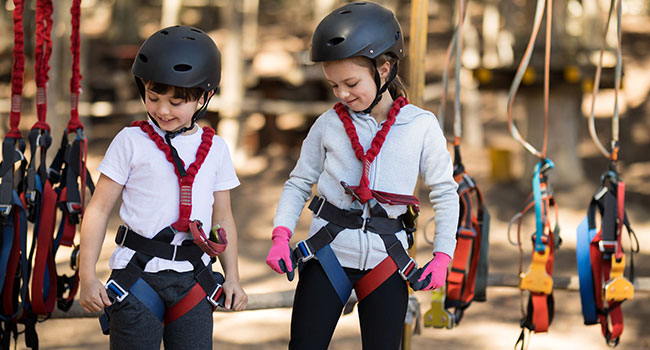
So, what to think about before building your own unique zip line will be a significant part of making your experience both successful and enjoyable. There are many variations of zip lines as well as how they are used; some zip lines are for sightseeing while others may be built purely for speed rather than simple enjoyment. But which type will be the best zip line equipment and style for what you are wanting to achieve? There are many factors to consider, including the environment your zip line will be in, how long it will be, how much you’re willing to spend, and so on. Here are some of the things to consider.
Where Will You Set up Your Zip Line?
Most zip lines are attached to trees, poles or other surfaces with a platform that can be guaranteed to be solid. Depending on what design you are considering, many zip lines will use poles, or possibly trees. It is always safest to err on the side of safety, so consider using guy wires to steady the pole or tree and maintain them upright to counteract the pulling force and weight of the cable and the rider. If you are attaching your zip line to
How Much Longer Cable Line Do You Need?
While the obvious answer is that you will need enough to go from the highest to the lowest point, there are other items to consider. Depending upon the weight, diameter, and composition of your cable, there will most likely be some degree of sagging. This will have to be stretched out, but nonetheless, you will have to have enough cable at the end of the run to stretch the cable out. In addition, even the tightest cable, rope or line will suffer
How Much Weight Should the Cable Line Endure?
The cable will have to endure its own weight and also the added weight of the rider and the materials that are used to support the rider. A cable supporting a 100-pound child with a simple pulley and sling can be thinner than one supporting a 250-pound large adult with safety equipment, brakes, secondary pulleys and so on. There comes a point of diminishing returns; as the cable’s ability to hold a certain weight continue so does the
Estimate the Height of the Starting and Finishing Point
This is where complications in your setup can arise – careful attention is required here. Designing a zip line must take into account the pitch, determined by measuring the height of the starting and finishing points. A slightly downhill pitch is ideal; the angle changes depending upon its length. To manage speed, the line should be long enough for friction to slow the rider at the end of the run. Also, your zip line will sag roughly five
What Sort of Harness/Equipment Are You Looking For?
There are a number of concerns to consider, based on the age and abilities of a rider. Undoubtedly, a climbing or safety harness would be the safest and easiest for riders, but there will be additional issues of understanding how the harness works and changing it to fit various writers. While building your zip line system, you could use a set of straps to sit in, or even a bar to grip. But caution must be emphasized in using these
How Much Are You Willing to Spend on Equipment?
is always a concern for anything we use. And given the very narrow breaking point between safety and economy, it is a consideration you should examine closely. For example, the pulleys used on the zip line itself that is commonly recommended by various experienced users and builders seldom run for less than one hundred dollars per pulley! Yet you can get around two hundred fifty feet of high-quality three-eighths
Installation of Your Backyard Zip Line
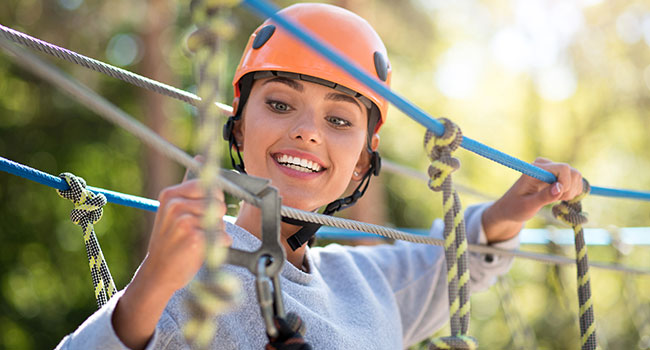
If you’ve decided to take the plunge and build your own zip line, congratulations! There are a number of things to consider in the process of installing the zip line that you should consider early on. In fact, it may be wise to determine these installation steps while you are in the process of designing the zip line so that you will be able to overcome unexpected roadblocks. For example, if you know where you want your zip line to be placed and how fast it will go, you can decide whether it is worthwhile to purchase installation tools, or if you would rather rent or borrow the items that you don’t have or are uncommon tools. Some of the concepts and jobs you will have to consider will include choosing two solid objects that will work for your zip line, stretching out and attaching the cable, using temporary clamps that will allow you to check your cable placement, and then adjusting the cable tension in a manner that will ensure functioning in the manner that you want it to. Once your zip line is set up, the final step will be to add the accessories you want before taking your first ride!
Choose Two Solid Objects
that will suit your desires, such as height from ground, sturdiness, distance between these attachment points and the pitch desired. Some people choose to use trees that are planted in their area, whereas others may use poles made of metal or concrete. Be certain that there are no obstacles in the proposed path of your zip line, such as branches, fences or wires. Even if it doesn’t seem like an object crossing the pathway of your zip line
Stretch out the Cable
so that you can be certain you have enough cable depending on the distance and pitch you’re going to use. As mentioned previously, there can be as much as five percent sag in the zip line, so be certain that your measurements are accurate. You will have to mount the cable on one of the solid objects, and then pay out the cable from its storage item, whether that be a spool, a box or another method. Longer distances may have
Attach the Cable
to your upright with the extra amount of cable that is left over from stretching it out between the two uprights. If you are using a tree, one issue to consider is that, as the tree grows, it will eventually grow around the cable. Prevent this by using a spacer between the tree and the cable, such as waterproofed lumber. Once you have your upright prepared, you will wrap the cable around it – at least twice – and then secure it. If you are
Use a Temporary Clamp
Make use of a temporary clamp to get your line in place, rather than your permanent clamps. This will allow the come-along, winch or another device that you will use to stretch the cable something to grip, but it won’t cause an issue if it is bent or damaged in the process. This clamp must be attached at least twenty feet from the upright, allowing you to hold tension on the cable. This is important – it holds the cable secure as you begin to fasten the free end of the cable
Adjusting Cable Tension
This will be the next step in building your zip line. Now that the cable is suspended in the air, you must ensure that you have a safe amount of sagging in the line, but not too much. If your sag exceeds five percent of the total length of the line, you could have issues. For example, too much slack in the middle of the zip line could cause a faster acceleration to the mid-point of the slack, and then deceleration as the rider and equipment
Adding the Accessories
This one will be the last step in installing your backyard zip line. Once you are certain your uprights are solid, your cable is properly strung, has the correct amount of sag and is secure, it’s time to test the entire system. With a simple pulley and lanyard, you should make test runs by gradually increasing the weight on the zip line, allowing it to run the course, observing the results and making adjustments until everything is perfectly set up for you.
Backyard Zip Line Accessories
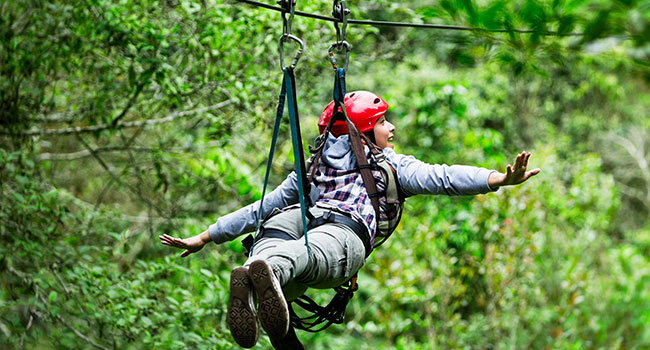
In order to stay safe while riding your zip line, there are a number of accessories you could use. You may see things such as kits that include handlebars to hang on to, or simple rope lanyards with a wooden seat at the end of it. However, these types of accessories tend to increase the risk of riding a zip line – so much so that adventure parks or other commercial businesses offering zip line rides use advanced equipment that increases safety by ensuring riders remain oriented facing the front of the zip line and are attached not only via a harness, but also have additional safety measures to prevent unhooking from any accessory while riding the zip line. Based upon these standards, here are some of the accessories you may want to consider:
Most commercial systems use a thick, multiple wire twisted cable such as airplane cable (used to tie airplanes to runways in storms and so on). This would be an ideal zip line as mentioned in previous paragraphs, but other cables can be considered as well. As this is the main functioning part of the ride, it would be wise to
A cable sling is often used when you are wrapping your zip line cable around the upright, especially trees. These are specially made lengths of cable with loops worked into each end, and come in various lengths. By wrapping one or more cable slings around your uprights, the loops will gather into one area, where they
Bungee cords are a commercial favorite to use as a braking system on zip lines. Stringing one or more bungee cords just below and perpendicular to the zip line, the rider’s lanyard will catch these cords, which will absorb the rider’s momentum and slow them. Paracord commonly used to connect a parachute harness
The trolley rests on the zip line cable, and what the rider will use to connect to the system. These vary from a single pulley with a handlebar attached to it for low-height children’s systems to lightweight, high tech multi-pulley systems that will achieve fast speeds safely. There are many options to examine when
These gated attachment devices are a staple item in rock climbing and mountaineering. Consisting of a metal loop with a moveable, spring-loaded gate that allows ropes, cables or links to attach but not detach without compressing the gate down. There are now many different varieties of carabiners due to their usefulness in
Many commercial zip lines use harnesses to attach a rider to the trolley, and these harnesses tend to either be rock climbing gear or heavy-duty safety harnesses. The reason that these more complex sets of straps and pads are used is due to their added safety, given that anyone who rides a zip line will be traveling at a
Typically made from webbing or other rock climbing materials, lanyards are the interface between the trolley and the rider’s harness. As such, these are a very important piece of equipment, as the rider will hang suspended from the trolley by the lanyard. There are a number of different lengths of lanyards that can be
When examining the braking systems, it is important for the design of your backyard zip line to understand that there are two main categories seen in zip line braking systems. Active braking is typically attached to the rider’s system and relies on the rider to activate the system to slow down. The other method
Specific to using trees as your starting and ending uprights, tree protectors are specifically created to prevent the cable from rubbing and pressing into and through the bark on the tree. Some kits are commercially available, using a combination of cable slings, rubber blocks, and nylon straps. Other tree protector kits can be
While you may not be required to wear a helmet on your backyard zip line system, good luck in getting onto any commercial zip line system without one. While nearly any helmet that is commercially certified to protect the head would be adequate, many commercial rides use rock climbing or skateboarding helmets to
Zip line systems that are suspended high above the ground, have steep pitches or long runs would be much better served by using a harness. But for a short run, moderate height and slower speed zip line that may go from a playhouse to the ground could certainly use a straight handlebar. A straight bar could be created
For those backyard zip lines that aren’t set up for a harness, a seat system could be used instead. This can be anything from a wooden seat with holes bored into them to pass a knotted rope through to actual ‘Swiss seat’ style systems, which are typically made for impromptu rappelling. There are even plastic enclosed
Zip Line Installation Tools
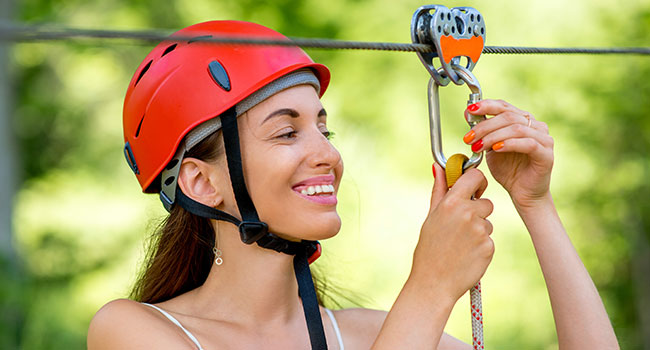
While a great deal of the zip line can be installed using common hand tools or tools that are routinely found in hardware stores, there are some tools for mounting, stretching, securing and finishing your backyard zip line that are important to have. As such, these tools tend to be specialized to handling or securing cable and are items that are mandatory for the backyard zip line to be completely safe for use for years. Some of these specialized tools include:
These clamps often consist of a U-shaped bolt that fits into a knuckled base, which looks quite like a flat plate with one or more cradles on them to hold cables. Cable clamps are often used for high wire rigs, slackline setups, rope obstacle courses, and zip lines. These can also be found labeled as cable clips or cable
Quite like cable clamps, suspension clamps are used to clamp something to a cable. However, these types of clamps consist of at least two flat or curved plates that are placed on each side of a cable and then clamped together by slipping a bolt through one or more holes in each side of the clamp. Suspension clamps can be
iiiThimble
When a cable line or wire rope is to end in a loop a thimble is used to make certain that the cable or wire doesn’t bend too tightly. This is important, especially when the cable is terminated is carrying a lot of weight or is under a great deal of tension. By making certain that the loop maintains a shape, the thimble can also reduce or
To stretch your cable, a cable grab, or cable grip can be used to grip the end of the cable. The other end of the cable grab is attached to a come along, winch or whatever you plan to use to pull the cable taut. A cable grab tool will pinch the end of the cable in a vice-grip; correct sizing of a cable grab depends on the cable
This is not a tool, but an important concept; the working load limit is the maximum force that may be safely placed upon a piece of equipment that is suspending something above the ground. This may also be seen as the greatest amount of force each component can handle routinely. The rating is usually marked on the
These copper sleeves can be slipped over any two parts of a cable or cables to create a permanent, crimped on closure. This is done by swaging, where the shape and diameter of the sleeve is altered by forcing the sleeve to close and clamp over the cables. Because of this process, a swaged cable is usually very difficult to get
viiFist Grip
A fist grip is another type of clamp; these clamps are a two-part clamp where each part is a mirror image of each other. Typically, a fist grip has a bolt built into one side of the clamp, and a hole in the other side, with a U-shaped bar connecting the two. When each bolt is slipped through the hole, it surrounds the cable, and
viiiShackles
A shackle is also useful for connecting cables, especially those that have an eye (such as a cable sling, or a cable that uses a thimble to make the eye) as well as connecting to hardware that could be mounted on a start or finish point, such as an eyebolt. Shackles most often look like a U-shaped piece of metal with a bar
Formed by taking the non-threaded end of a bolt and twisting it into a loop, a nut eye bolt can be placed into a pole, a tree or other upright to create a secure anchor point. Anytime you need to attach the cable to an item that must be secure, eye bolts with nuts will not only create a fixed point but can be adjusted by
There are any number of additional zipline accessories for backyard installation, such as a drill to drill holes or to turn sockets, wrenches of various sizes to turn nuts, a winch or a come-along as well as rope for assisting the cable lifting, stretching and securing the zipline, and personal safety items such as heavy gloves and eye
Useful Tips
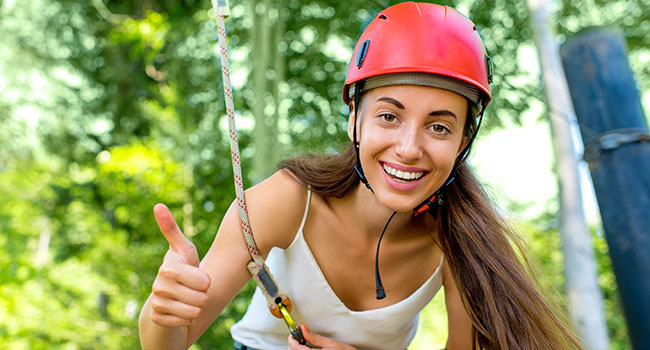
While building a backyard zipline isn’t a difficult task, it is something that isn’t done every day unless you are a professional installer. As such, there are many useful tips that we have gathered from across the internet that may help you with your zipline and zipline accessories for backyard installation.
Building Zipline without Trees
Some places either don’t have trees, of the trees, are not of sufficient size or height to hold up a zipline. In these instances, you may have to use poles with guy lines to hold them upright, or even create your start and finish points with concrete or other sufficiently strong materials. Regardless of what you choose for your uprights, they must be strong enough to hold the zipline under tension and while be ridden upon. Even if your
Sufficient Cables or Ropes
When you are in the process of designing your backyard zipline and purchasing supplies, ensure you have enough cable and/or rope to complete the assembly. Even if you have chosen to use a zipline kit, there must be enough cable to reach from upright to upright plus quite a few feet left over to wrap around or otherwise secure the zipline and provide slack to clamp the cable. In addition, ropes can be useful to help lift and stretch
Permission for Ziplines
Depending upon the location of your zipline and who will be using it, there could be different permissions required to create, assemble and use your zip line equipment. One issue to investigate will be if there is a permit needed; most areas will not regulate backyard zipline building specifically, but because of the concerns of falls and other accidents, may require inspection or a permit before use. In addition, if the zipline is to be
Liability Insurance
Even if not required by your location or community, it is often a wise decision to purchase liability insurance for yourself and for your equipment. This will help to protect you from legal actions if they should occur, and if there is an injury or another issue when someone uses your zipline, it can absolve you of responsibility. In addition, insurance can help to repair or replace zipline parts if they wear out, are damaged by the environment or
Build within Your Limits
It is not uncommon for people who ride a zipline to enjoy the thrill of flying through the air at speed. But it is a slippery slope between a zipline that is fun to ride and a zipline that is dangerous or so fast and steep that it is scary rather than fun. Each backyard zipline will be an individual creation, but at the same time, must be built within dimensions that will provide the most enjoyable ride. This consideration is especially
Health Considerations
Tying in with the idea of building within your limits, you should also be aware of health conditions that riders have. You must protect your health as well as be responsible for knowing the health issues of the riders on the system. It would be a terrible thing for a rider to have a health issue such as a cardiac condition that could lead to a heart attack, or pain in joints that could easily be managed by a little extra padding in the harness, and
Testing the Zipline
Once your zipline is assembled, it may be tempting to climb aboard and ride it immediately – but this is a not a good idea! You should test your backyard zipline before anyone rides it by using a ‘dummy weight’. It is a good idea to use the actual equipment you plan to ride with and load it with the same weight of the heaviest rider you expect to use it. This will let you examine the ride in action, and see how low the cable will bring the rider
Safety in Use
As with any outdoor equipment and event, a zipline must be used with safety in mind, especially with new riders or kids. In order to do this, there are a few guidelines you will want to enforce. Loose clothing or items that might get caught in the trolley, a pulley or other apparatus (such as scarves or jewelry) should be taken off or exchanged for tighter fitting clothes. In the same manner, riders with long hair should tie it securely, or put it up under
Supervision
Regardless of the age of the rider, there should be another person who is there when the rider takes off from the starting point. Without someone to supervise the ride, there will not be anyone available to assist if something goes wrong. Examples include if a piece of equipment malfunctions, the rider has a crisis (such as fainting), or the equipment gets stuck at a certain point and there is no way to get to a safe point to disembark. These are
Zipline Termination Tips
If you are setting up your zipline to use eyebolts, make certain that the washers you use on the threaded end of the eyebolt are wide enough to prevent the nut from being pulled into the upright. If you have decided to use a strap or a cable sling, be certain that the item you’ve chosen are rated well beyond the working load limit to insure they will not deteriorate under stress. If you choose to wrap your strap or cable around a tree, utilize a
A backyard zipline is a wonderfully entertaining project that can provide fun for years. As you can see by this article, it isn’t anywhere near as difficult to create your own zipline, whether from a zipline kit and additional zipline accessories for the backyard, or simply assembling one from your own imagination. Safety is paramount because of the speeds and the height the ride takes place at, but these issues are easily addressed, and simple to manage through careful use. So, give it a try – regardless of whether you have trees or not, you can purchase zipline accessories for backyard ziplines and have your friends and family gleefully flying through the air in no time.


